 to display picture, use
your browser back-arrow to return.
to display picture, use
your browser back-arrow to return.
|
Story in the Australian, 1975. The OZNAKI Project at La Trobe University was in 1975 one of the very few computer projects anywhere directed at primary school students. In 1976 it became the first educational project world-wide using microcomputers. The very first microcomputer LOGO was developed at La Trobe. |

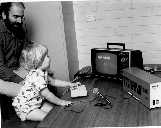 á
áPROTOTYPE PROGRAM VERSIONâ Modelled operation of addition (+) and subtraction (-) by adding/subtracting from thenumber of lights on. This toddler's calculator, with large + and - keys, featured row of 9 lights, each above a number 1 ..9. illuminated in Cusinere colours. The user is aged 20 months. This electronic calculator was replaced by graphics program PLUSMINUS in 1977, where either a large two key pad was used, or speech input via a microphone. Computer was the Poly-88, with same "s-100" bus as the Altair. Speech Input was via Heuristics SpeechLab a s-100 bus speech I/O board. See pix speech I/O |
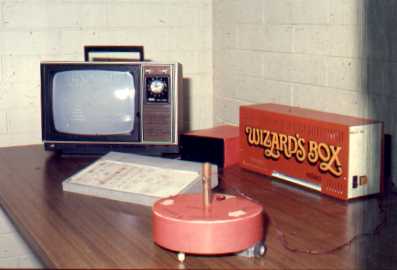
OZNAKI Turtle robot (1976) ZONKY the first TurtleRobot constructed outside US/UK, could go F(orward), B(ack), R(ight), L(eft), while H(onking) and A(light), and sing a simple tune. |
|
|
Computer Communication Access and Programming by Severely Disabled Project evolved from the Oznaki Project |
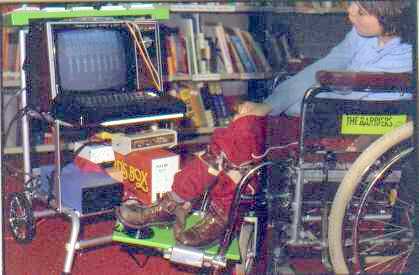
Non-vocal handicapped user of PLUSMINUS via prototype Talking Communicator The prototype was based on the Poly-88, which was in 1976 the first Intel 8080 microcomputer with built-in graphics. The subsequent TRX-80 was of similar configuration -- but in the astonishing maufacturing volume of 20,000 p.a. |
| One feature of OZNAKI block graphics was the possibility of rendering a design with scaled copies of itself. This is actually the key idea in fractal image compression. For more about the block-recursive fractal concept. see the web account of the version of WHAM tailored for the MicroBee called OZLogo |
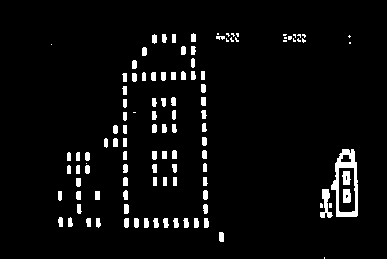 Screen shot of Poly-88 WHAM circa 1978.
The turtle has been directed about the 16X16 region to the left,
by LOGO commands, marking or unmarking each square.
Then this region has been "snapped" to produce the icon on lower right.
Note that in the
MicroBee
version, called OZLogo this new icon can used by the screen turtle (NAKI)
to mark squares.
Screen shot of Poly-88 WHAM circa 1978.
The turtle has been directed about the 16X16 region to the left,
by LOGO commands, marking or unmarking each square.
Then this region has been "snapped" to produce the icon on lower right.
Note that in the
MicroBee
version, called OZLogo this new icon can used by the screen turtle (NAKI)
to mark squares.
|
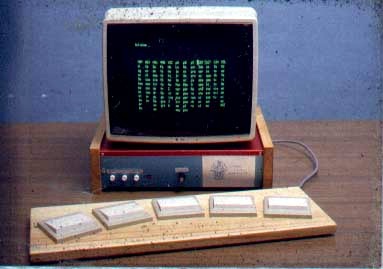
Talking Communicator Mark ][ Circa March 1983 with 5-key keyboard for students with moderate impairment. Ten Communicators were developed and programmed for specific students at the Yooralla Special School, Melbourne. Speech output was via the Votrax SC-01 phoneme generator,which was the very first speech chip commercially released in 1981/2. The single-board computer that powered this unit was in fact the motherboard of the early version of the Australian microcomputer, the MicroBee. The Talking Communicator Project is detailed in papers listed and in some cases Downloadable. |
|
OZNAKI Project was concerned with objective evaluation
via psychometric tests.
One intriging test
was the
|

Click to View a Larger Image of the Maze used in studies of Projective Ability | With the experimental group of 27 children aged 8 - 13, only 4 could perform this task in the pretest. whereas, after 8 lessons with OZNAKI 21 succeeded. On the other hand, in the matched control group, 4 out of the 27 initially succeeded, whereas when the test was presented again, only 3 succeeded. Other improvements were as large and generally consistent. |

|
|
 Harvey Cohen's Home Page
and his political page Harvey Cohen's Home Page
and his political page
|